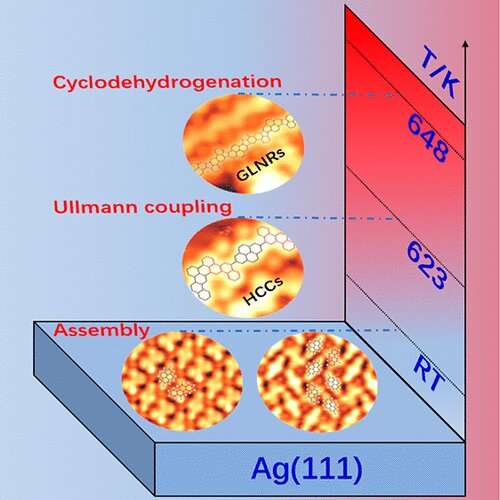
Graphene nanoribbons (GNRs) have attracted much attention due to their unique electronic structures with high tunability of physical structures.
However, the fabrication feasibility of artificially tuned GNRs intrinsically associated with their external properties brings considerable challenges in the synthesis of GNRs and their utilization in devices.
Now, a research team led by Prof. Song Fei from the Shanghai Advanced Research Institute (SARI) of the Chinese Academy of Sciences has reported a novel approach to precisely fabricate well-defined GNRs with the tailored pentagon carbon embedded inside and supported on the Ag(111) model catalyst. The results were published in the Journal of Physical Chemistry Letters on May 25.
Compared with the conventional solution-synthesis chemistry, on-surface Ullmann coupling strategy introduces feasibility and controllability on demand towards the atomically precise nanostructures of well-modified GNRs, through programmed cleavage of carbon-halogen bonding in precursors and the reconnection of carbon-carbon bonding on surface.
Moreover, by utilizing multiple precursors as designed, pentagon carbon structures can be feasibly introduced into GNRs via Ullmann coupling and cyclodehydrogenation on Ag(111), realizing the artificial modification of both nanostructures and electronic structures with high stability, as witnessed by scanning tunneling spectroscopy and density function theory.
This study provides a novel strategy to promote on-surface GNRs-based nanostructures towards field effect transistors, high-density storage devices, etc.
More information:
Hongbing Wang et al, On-Surface Synthesis of Pentagon-Incorporated Graphene-Like Nanoribbons with Multiple Precursors, The Journal of Physical Chemistry Letters (2023). DOI: 10.1021/acs.jpclett.3c01234
Provided by
Chinese Academy of Sciences
Citation:
Novel approach to fabricating artificial graphene nanoribbons with embedded pentagon carbon (2023, June 16)
retrieved 16 June 2023
from https://phys.org/news/2023-06-approach-fabricating-artificial-graphene-nanoribbons.html
This document is subject to copyright. Apart from any fair dealing for the purpose of private study or research, no
part may be reproduced without the written permission. The content is provided for information purposes only.










